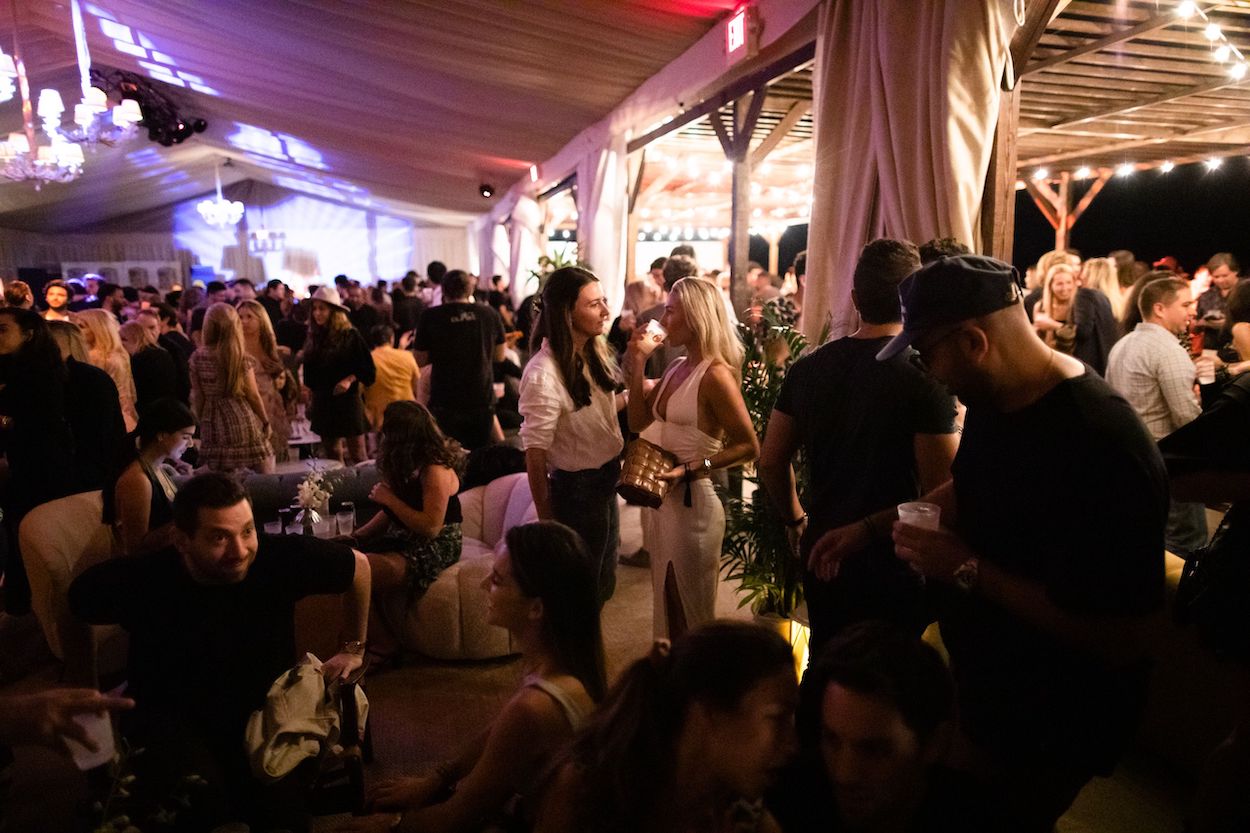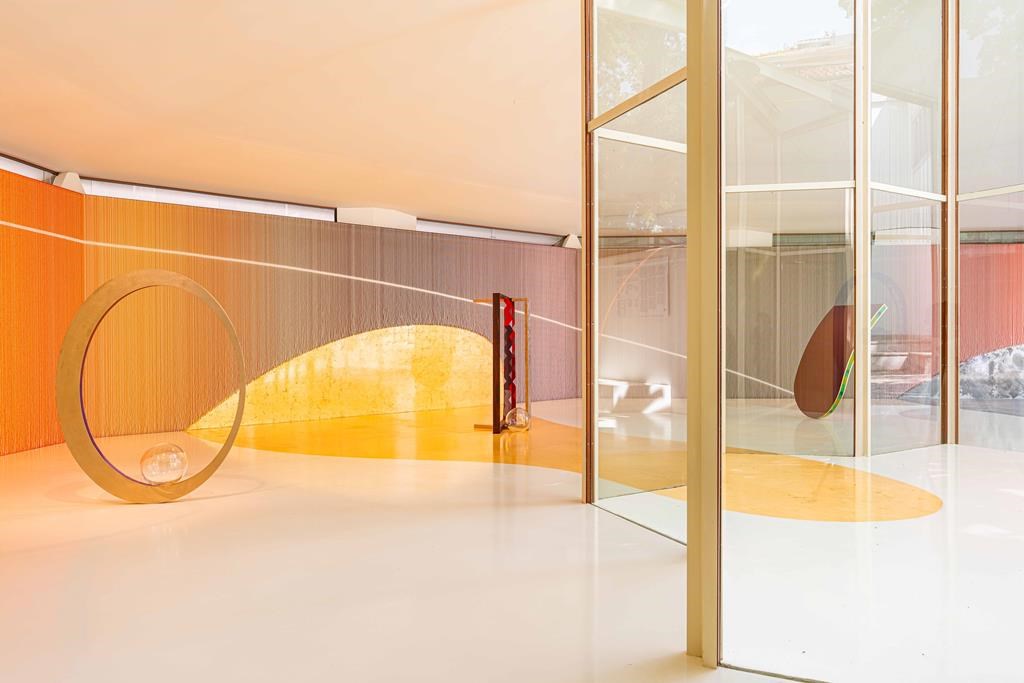Art
Was Miami Art Week a Superspreader Event? – SURFACE – Surface Magazine


In case you haven’t noticed, the Omicron variant is ripping through New York City and many other places around the globe. On Sunday, the New York Times noted that the number of locals who tested positive for Covid-19 just broke a single day record with over 28,000 newly reported cases. Locals are reporting three-hour waits for Covid tests at urgent care, dozens of restaurants and bars have temporarily closed, office holiday parties are being canceled, and Broadway shows are being put on hold. Despite the sharp uptick in Covid-19 cases due to the Omicron strain in places like London, India, and more, some are blaming Miami Art Week, which lures New Yorkers in droves, as a superspreader event.
Centered around the marquee Art Basel Miami Beach and Design Miami fairs, the event held from Dec. 2-4 heralded a return to normalcy for an industry whose tolerance for virtual viewing rooms and Zoom cocktails has waned. (Surface was no exception, hosting several panel talks and dinners during the week.) Naturally, many attendees and artists—painter Chloe Wise and NFT artist David Bianchi, among others—are now sick with Covid. “I attended Art Basel Miami and have tested positive for Covid, the travel blogger Kristi Vikman told Observer. “The only place that checked vaccination cards was the actual convention center [where Art Basel took place]. And masks were optional everywhere. Parties were packed. No sanitizer or masks to be seen.”
So who’s to blame for the outbreak? It’s impossible to point a finger at any single cause, and safety standards were certainly more lax in Miami and Florida overall (as they have been since the onset of the pandemic, with varying results that are constantly compared to stricter regulation states like California.) Some attendees say crowded parties and dinners weren’t checking vaccination cards; masks and sanitizer were nowhere to be found, and many Uber drivers weren’t strictly enforcing mask mandates. While the Art Basel fair required proof of vaccination (a recent negative Covid-19 test or proof of recent covery from the virus were also accepted) and mandatory mask-wearing within the Miami Beach Convention Center, enforcing those standards for an event that drew 60,000 visitors presents an untenable challenge.
The elephant in the room is that Miami Art Week coincided with the rise of Omicon, a variant that a new study says multiplies 70 times faster inside the human respiratory tract. Is the event to blame for the outbreak in New York? Maybe. But there’s also an argument to be made that New Yorkers brought it to Miami. Sadly, it seems Omicron was coming no matter what.
Art
DC Knights call for Rupnik art removal – The Pillar
A Washington, D.C., Knights of Columbus council has called for chapel mosaics created by disgraced artist Fr. Marko Rupnik to be removed from the area’s St. John Paul II Shrine, which is sponsored by the Knight of Columbus fraternal organization.


The Cardinal O’Boyle Council 11302 passed a resolution April 9 calling on Knights leadership to remove Rupnik’s artwork from the shrine’s Redemptor Hominis Church and the Luminous Mysteries Chapel.
The resolution notes that Rupnik has been accused of sexually abusing religious sisters in the context of creating his works of art.
“O’Boyle Council calls upon the executive leadership of the Washington, DC State Council of the Knights of Columbus (State Council) and the executive leadership of the Supreme Council of the Knights of Columbus (Supreme Council) to renovate the Shrine such that the mosaics in both the Redemptor Hominis Church and the Luminous Mysteries Chapel created by Fr. Rupnik are removed and replaced with liturgical art suitable to the celebration of the sacraments,” says the resolution, which was obtained by The Pillar.
The council calls on Knights national leadership to immediately publicize a plan for a removal of the artwork and to cover the images until a full renovation can begin.
“O’Boyle Council calls upon the executive leadership of the Washington, DC State Council and the executive leadership of the Supreme Council to immediately make a public apology to survivors of Fr. Rupnik’s abuse for the Order’s continued inaction in addressing the matter of the mosaics in the Shrine,” the resolution adds.
Rupnik is a well-known Slovenian priest, an artist, and a former member of the Jesuit order, the Society of Jesus.
The priest is at the center of a multi-faceted sexual abuse and cover-up scandal. Rupnik has been accused of spiritually, psychologically, and sexually abusing consecrated women in a Slovenian religious community. He was also briefly excommunicated in 2020, for attempting to sacramentally absolve a woman after a sexual encounter with her, a major crime in the Church’s canon law.
An initial examination of the allegations against Rupnik met a dead end when the Dicastery for the Doctrine of the Faith (DDF) declined to lift the statute of limitations on the allegations.
Amid widespread criticism, Pope Francis in October 2023 waived the statute of limitations on the claims against Rupnik, reopening the case against the priest, and allowing him to face a canonical process.
The DDF is currently investigating the allegations. Five new complaints of abuse were filed with the dicastery earlier this month.
The allegations against Rupnik have led to calls for the removal of his artwork, which is prominently featured in sacred spaces around the world, including the Basilica of the Sanctuary in Lourdes, France.
In December 2022, the Knights of Columbus said it was “reconsidering the place” of Rupnik’s work in the organization’s chapels. The Knights have already removed Rupnik’s art from their evangelization booklets and other published materials.
The O’Boyle Council resolution cites Sacrosanctum concilium’s exhortation that works of art which are “repugnant to faith, morals, and Christian piety” should be removed from sacred spaces.
“[T]he mosaics created by Fr. Rupnik in the St. John Paul II Shrine are repugnant to faith, morals, and Christian piety due and lack artistic worth due to the fact that Fr. Rupnik reportedly perpetrated his sexual abuse through the creation of his artwork,” the resolution states.
Rupnik’s mosaics are also featured in Holy Family Chapel, at the Knights of Columbus’ headquarters in New Haven, Connecticut.
The Knights of Columbus did not respond to The Pillar’s request for comment on the O’Boyle Council resolution.
Comments 26
Art
Canada's art installation at Venice Biennale rooted in research, history, beauty – CityNews Toronto


Hundreds of thousands of tiny glass beads will soon be twinkling in the sun across the entire Canadian pavilion at the Venice Biennale, Canada’s newly revealed entry in one of the world’s most prestigious art fairs.
But Kapwani Kiwanga, the Hamilton-born, Paris-based creator of the work, wants you to get past the cobalt blue glass glinting in the Venetian light. She wants you to think of each bead as a character.
“The materials are documents of themselves,” she says. “They’re witnesses.”
The beads used in her installation “Trinket” were made on the nearby Venetian island of Murano. Centuries ago, similar beads were used all over the world as both desirable trade goods and currency in themselves.
Their name, “conterie,” comes from the Portuguese word for “count.”
“I never use (materials) just because they’re esthetically pleasing,” Kiwanga says. “That comes into it at one point but it’s really their social, cultural and economic history that makes me want to settle on a material.”
Kiwanga’s installation at the Canada Pavilion was revealed Tuesday, more than a year after she was named Canada’s representative to the 60th Venice Biennale.
Kiwanga has previously installed works at art galleries and fairs from Saskatoon to Dublin and London to Istanbul.
She has won major art prizes in Canada and France, and bagged nominations from the British Academy of Film and Television Arts for her film work.
Throughout all that work, she says, runs her interest in what materials have to say for themselves.
Sometimes, plants do the talking. One of her previous installations, “Flowers for Africa,” uses familiar flowers like gladioli that originated in Africa.
They may look arranged for a posh wedding or upscale hotel lobby, but are recreations of flower arrangements created for diplomatic events linked to independence negotiations for African countries. The arrangements gradually wilted, evoking emotions about the passage of time and the fleeting nature of pomp.
In other works, colours speak to the audience.
“Linear Paintings” explores hues believed to promote certain moods and used by industrial designers to cover walls in offices, mental health hospitals and prisons.
“I’m thinking of them as characters who have witnessed a past event,” Kiwanga says. “History is a starting point for a lot of my work, although I’m thinking about our present and sometimes our future as well.
“My larger question or interest is power and power dynamics.”
She wants viewers to consider her work a kind of “gateway.”
“I’m not trying to prove anything. I’m not looking for materials that prove a point. I’m just saying the who or the how or the what,” she says.
The work begins with a vague notion of something interesting that sheds a bit of light on how the world operates.
Then it’s study time. Popular and academic works on the theme are consulted, experts are interviewed, archives combed. She says about 60 per cent of the work needed to create a new piece is done in the library, not the studio.
Kiwanga credits her anthropology degree from McGill University with giving her the research skills necessary to her artistic practice.
For her sense of the world, she gives some credit to Hamilton. She now divides her time between Canada, France and Tanzania, but it was Steeltown that first showed her the world is a big place.
“Growing up in downtown Hamilton was quite diverse,” she says.
“In my Grade 1 class — I remember this — we had people from all over the world, some of whom had just arrived. The world already was in this tiny little bit of my reality.”
Being chosen to represent Canada at the nearly 130-year-old Venice Biennale “was a great honour,” she said.
Canada has been represented at the art fair since 1952. This year’s version will see 63 countries participating.
Previous Canadian representatives have included illustrious artists such as Alex Colville, Michael Snow and Stan Douglas — and that creates a certain pressure, Kiwanga admits.
“One person is chosen every two years, but there are so many other artists who could have been chosen and done something amazing. I felt a responsibility.”
But just being part of a global art conversation will be a highlight, Kiwanga says. And true to form, she’s already thinking of the Biennale as another kind of document.
“When we’re all together and we end up finishing our works, what’s it going to say about this moment?”
The Venice Biennale international art exhibition runs from April 20 to Nov. 24.
This report by The Canadian Press was first published April 16, 2024.
Bob Weber, The Canadian Press
Art
Canada's art installation at Venice Biennale rooted in research, history, beauty – Toronto Star


/* OOVVUU Targeting */
const path = ‘/entertainment’;
const siteName = ‘thestar.com’;
let domain = ‘thestar.com’;
if (siteName === ‘thestar.com’)
domain = ‘thestar.com’;
else if (siteName === ‘niagarafallsreview.ca’)
domain = ‘niagara_falls_review’;
else if (siteName === ‘stcatharinesstandard.ca’)
domain = ‘st_catharines_standard’;
else if (siteName === ‘thepeterboroughexaminer.com’)
domain = ‘the_peterborough_examiner’;
else if (siteName === ‘therecord.com’)
domain = ‘the_record’;
else if (siteName === ‘thespec.com’)
domain = ‘the_spec’;
else if (siteName === ‘wellandtribune.ca’)
domain = ‘welland_tribune’;
else if (siteName === ‘bramptonguardian.com’)
domain = ‘brampton_guardian’;
else if (siteName === ‘caledonenterprise.com’)
domain = ‘caledon_enterprise’;
else if (siteName === ‘cambridgetimes.ca’)
domain = ‘cambridge_times’;
else if (siteName === ‘durhamregion.com’)
domain = ‘durham_region’;
else if (siteName === ‘guelphmercury.com’)
domain = ‘guelph_mercury’;
else if (siteName === ‘insidehalton.com’)
domain = ‘inside_halton’;
else if (siteName === ‘insideottawavalley.com’)
domain = ‘inside_ottawa_valley’;
else if (siteName === ‘mississauga.com’)
domain = ‘mississauga’;
else if (siteName === ‘muskokaregion.com’)
domain = ‘muskoka_region’;
else if (siteName === ‘newhamburgindependent.ca’)
domain = ‘new_hamburg_independent’;
else if (siteName === ‘niagarathisweek.com’)
domain = ‘niagara_this_week’;
else if (siteName === ‘northbaynipissing.com’)
domain = ‘north_bay_nipissing’;
else if (siteName === ‘northumberlandnews.com’)
domain = ‘northumberland_news’;
else if (siteName === ‘orangeville.com’)
domain = ‘orangeville’;
else if (siteName === ‘ourwindsor.ca’)
domain = ‘our_windsor’;
else if (siteName === ‘parrysound.com’)
domain = ‘parrysound’;
else if (siteName === ‘simcoe.com’)
domain = ‘simcoe’;
else if (siteName === ‘theifp.ca’)
domain = ‘the_ifp’;
else if (siteName === ‘waterloochronicle.ca’)
domain = ‘waterloo_chronicle’;
else if (siteName === ‘yorkregion.com’)
domain = ‘york_region’;
let sectionTag = ”;
try
if (domain === ‘thestar.com’ && path.indexOf(‘wires/’) = 0)
sectionTag = ‘/business’;
else if (path.indexOf(‘/autos’) >= 0)
sectionTag = ‘/autos’;
else if (path.indexOf(‘/entertainment’) >= 0)
sectionTag = ‘/entertainment’;
else if (path.indexOf(‘/life’) >= 0)
sectionTag = ‘/life’;
else if (path.indexOf(‘/news’) >= 0)
sectionTag = ‘/news’;
else if (path.indexOf(‘/politics’) >= 0)
sectionTag = ‘/politics’;
else if (path.indexOf(‘/sports’) >= 0)
sectionTag = ‘/sports’;
else if (path.indexOf(‘/opinion’) >= 0)
sectionTag = ‘/opinion’;
} catch (ex)
const descriptionUrl = ‘window.location.href’;
const vid = ‘mediainfo.reference_id’;
const cmsId = ‘2665777’;
let url = `https://pubads.g.doubleclick.net/gampad/ads?iu=/58580620/$domain/video/oovvuu$sectionTag&description_url=$descriptionUrl&vid=$vid&cmsid=$cmsId&tfcd=0&npa=0&sz=640×480&ad_rule=0&gdfp_req=1&output=vast&unviewed_position_start=1&env=vp&impl=s&correlator=`;
url = url.split(‘ ‘).join(”);
window.oovvuuReplacementAdServerURL = url;
Hundreds of thousands of tiny glass beads will soon be twinkling in the sun across the entire Canadian pavilion at the Venice Biennale, Canada’s newly revealed entry in one of the world’s most prestigious art fairs.
But Kapwani Kiwanga, the Hamilton-born, Paris-based creator of the work, wants you to get past the cobalt blue glass glinting in the Venetian light. She wants you to think of each bead as a character.
function buildUserSwitchAccountsForm()
var form = document.getElementById(‘user-local-logout-form-switch-accounts’);
if (form) return;
// build form with javascript since having a form element here breaks the payment modal.
var switchForm = document.createElement(‘form’);
switchForm.setAttribute(‘id’,’user-local-logout-form-switch-accounts’);
switchForm.setAttribute(‘method’,’post’);
switchForm.setAttribute(‘action’,’https://www.thestar.com/tncms/auth/logout/?return=https://www.thestar.com/users/login/?referer_url=https%3A%2F%2Fwww.thestar.com%2Fentertainment%2Fcanadas-art-installation-at-venice-biennale-rooted-in-research-history-beauty%2Farticle_a66efe4f-272c-5284-ac9d-68125cd438dd.html’);
switchForm.setAttribute(‘style’,’display:none;’);
var refUrl = document.createElement(‘input’); //input element, text
refUrl.setAttribute(‘type’,’hidden’);
refUrl.setAttribute(‘name’,’referer_url’);
refUrl.setAttribute(‘value’,’https://www.thestar.com/entertainment/canadas-art-installation-at-venice-biennale-rooted-in-research-history-beauty/article_a66efe4f-272c-5284-ac9d-68125cd438dd.html’);
var submit = document.createElement(‘input’);
submit.setAttribute(‘type’,’submit’);
submit.setAttribute(‘name’,’logout’);
submit.setAttribute(‘value’,’Logout’);
switchForm.appendChild(refUrl);
switchForm.appendChild(submit);
document.getElementsByTagName(‘body’)[0].appendChild(switchForm);
function handleUserSwitchAccounts()
window.sessionStorage.removeItem(‘bd-viafoura-oidc’); // clear viafoura JWT token
// logout user before sending them to login page via return url
document.getElementById(‘user-local-logout-form-switch-accounts’).submit();
return false;
buildUserSwitchAccountsForm();
console.log(‘=====> bRemoveLastParagraph: ‘,0);
-
Tech2 hours ago
Motorola's Edge 50 Phone Line Has Moto AI, 125-Watt Charging – CNET
-
Media21 hours ago
Trump Media plunges amid plan to issue more shares. It's lost $7 billion in value since its peak. – CBS News
-



 Investment22 hours ago
Investment22 hours agoLatest investment in private health care in P.E.I. raising concerns – CBC.ca
-



 Politics24 hours ago
Politics24 hours agoQuebec employers group urges governments to base immigration on labour needs, not politics – CityNews Montreal
-



 Investment21 hours ago
Investment21 hours agoInvestors are growing increasingly weary of AI – TechCrunch
-
Business24 hours ago
Tesla to lay off 10% of its workforce as sales fall – CBC News
-
Real eState2 hours ago
Search platform ranks Moncton real estate high | CTV News – CTV News Atlantic
-
Media15 hours ago
Psychology group says infinite scrolling and other social media features are ‘particularly risky’ to youth mental health – NBC News






